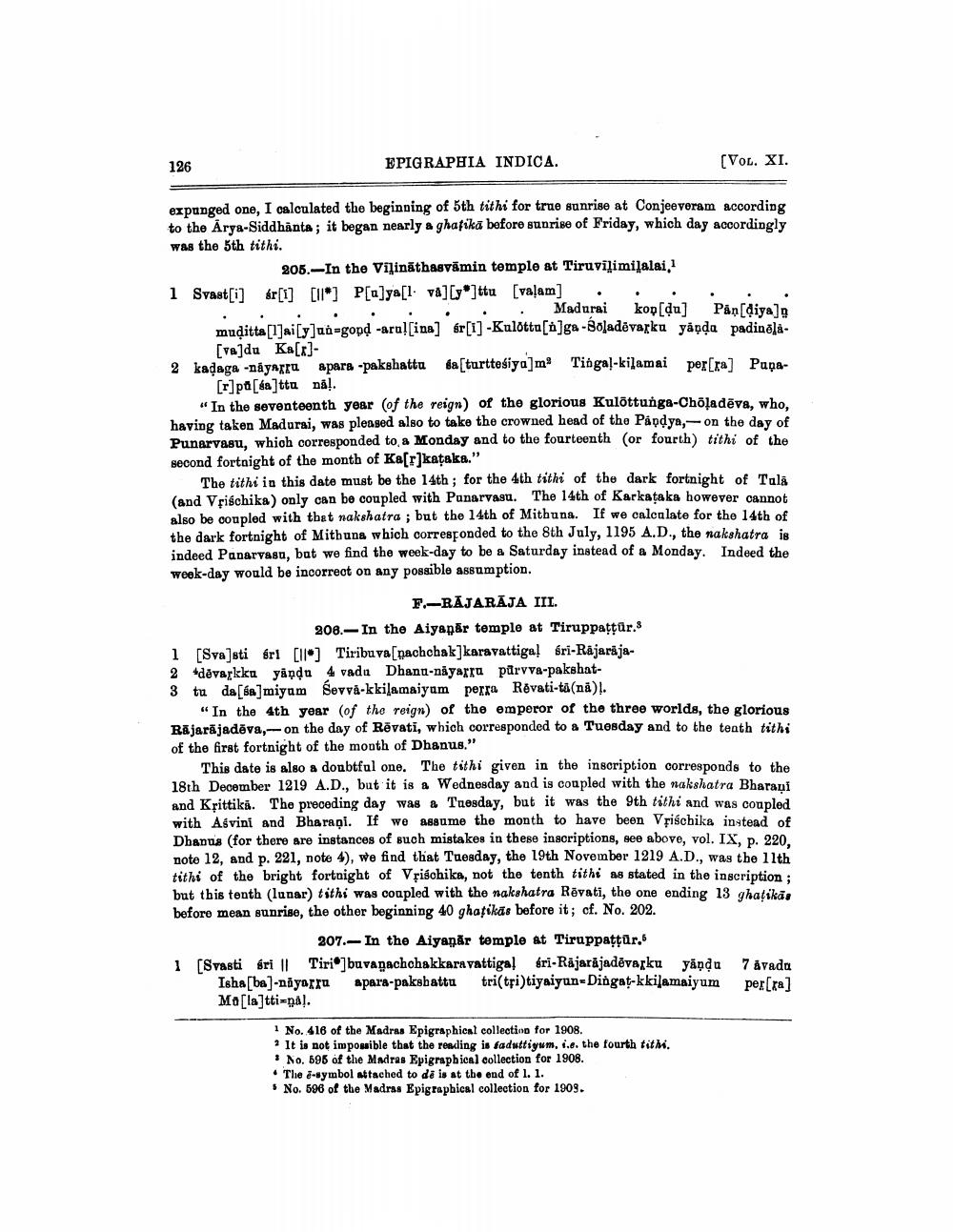________________
126
EPIGRAPHIA INDICA.
(VOL. XI.
expunged one, I calculated the beginning of 5th tithi for true sunrise at Conjeevoram according to the Arya-Siddhanta; it began nearly a ghafika before sunrise of Friday, which day accordingly was the 5th tithi.
205.-In the vilināthasvāmin temple at Tiruvilimiļalai, 1 Svast[i] &r[i] [II] P[a]ya[l: va] [y]ttu [valam] . . . .
. . Madurai kop [du] Pan[diya] muditta [1]ai[y]an-gopd -aru![ina] Sr[i] -Kulottu[n]ga -Boladóvarku yaşda padingla
[vajda Ka[x]2 kadaga -NÄYAITU apara -pakshattu asturttesiya]mo Tingal-kilamai per[ra] Papa
[r]pa[]ttu nå! "In the seventeenth year of the reign) of the glorious Kulottunga-Chöladëve, who. having taken Madurai, was pleased also to take the crowned head of the Papdya, on the day of Punarvasu, which corresponded to a Monday and to the fourteenth (or fourth) tithi of the second fortaight of the month of Ka[r]kataka."
The tithi in this date must be the 14th; for the 4th tithi of the dark fortnight of Tala (and Vrischika) only can be coupled with Panarvasu. The 14th of Karkataka however cannot also be coupled with that nakshatra ; but the 14th of Mithuna. If we calculate for the 14th of the dark fortnight of Mithuna which corresponded to the 8th July, 1195 A.D., the nakshatra is indeed Panarvasa, bat we find the week-day to be a Saturday instead of a Monday. Indeed the week-day would be incorrect on any possiblo assumption.
F.-RĀJARĀJA III.
208. - In the Aiyanar temple at Tiruppațţür. 1 [Sva]sti srl [ll] Tiribu va[nachchak]karavattiga! sri-Rajaraja2 dēvarkku yandu 4 vada Dhand-nsyarra pärvva-pakshat3 tu da [sa] miyam Sevva-kkilamaiyum perra Révati-ta(na)!
"In the 4th year (of the reign) of the emperor of the three worlds, the glorious BAjaräjadöva,--on the day of Rēvati, which corresponded to a Tuesday and to the teath tithi of the first fortnight of the month of Dhanus."
This date is also a donbtful one. The tithi given in the inscription corresponds to the 18th December 1219 A.D., but it is a Wednesday and is coupled with the nakshatra Bharani and Krittika. The preceding day was a Tuesday, but it was the 9th tithi and was coupled with Asvini and Bharani. If we assume the month to have been Vrischika instead of Dhanus (for there are instances of such mistakes in these inscriptions, see above, vol. IX, p. 220. note 12, and p. 221, note 4), we find that Tuesday, the 19th November 1219 A.D., was the 11th tithi of the bright fortnight of Vpischika, not the tenth tithi as stated in the inscription : but this tenth (lunar) tithi was coupled with the nakshatra Rēvati, the one ending 13 ghatikas before mean sunrise, the other beginning 40 ghatikās before it; cf. No. 202
207.- In the Aiyaņār temple at Tiruppatřür. 1 Svasti eri | Tiriobuvanachchakkaravattiga! fri-Rajarajadēvarku yaņdu 7 avada
Ishs[ba]-niyarru apara-paksbattu tri(tri)tiyaiyun-Dingat-kkilamaiyum per[ra] Mo[la]tti=pa!.
1 No. 416 of the Madras Epigraphical collection for 1908. ? It is not imposible that the reading is faduttiyum, 1.e. the fourth fitm. • No. 696 of the Madras Epigraphical collection for 1908. • The s-symbol attached to do is at the end of 1. 1. 5 No. 596 of the Madras Epigraphical collection for 1909.




